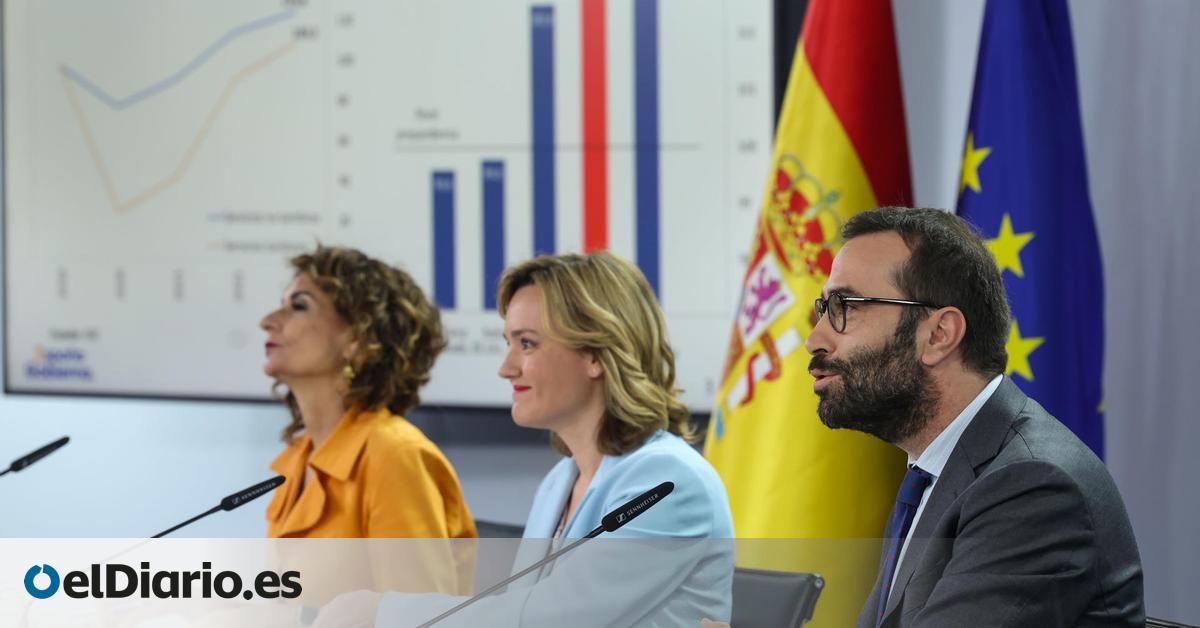
The Spanish economy has entered a new phase. After overcoming the double blow of the pandemic and the inflation crisis, activity is confirming a transformation that presents unprecedented strengths, such as the rise in business investment, the resilience of consumption due to the record pace of job creation, or the expansion of an external sector that is not only tourism.
The macroeconomic framework of the 2025 General Budget sets out a scenario of GDP (Gross Domestic Product) growth above 2% by 2027, in which the public deficit (the difference between State expenditure and income) will fall below 2% in relation to GDP and in which one million more jobs will be created, exceeding 22 million Social Security affiliates, to reduce the unemployment rate below 9%, a minimum not seen since the real estate bubble. But, this time, “without imbalances”, according to the Minister of Economy, Trade and Business, Carlos Cuerpo, on Tuesday.
This is a direction that has not been taken in the last 20 years, supported by the deployment of the Recovery Plan and with three major ‘musts’: the difficult access to housing and the slow reduction of inequalities, both aggravated by price increases since 2021; and, in addition, the deterioration of important public services, such as health and education.
According to the new projections that the coalition government published on Tuesday and on which the General State Budget (PGE) for 2025 will be based, the Administrations should have room to better distribute economic growth and address these problems. In this new exercise of forecasts, it is highlighted that the Executive trusts that the positive inertia will continue in 2027, when it is the first time that it makes estimates, and that the limit that the return of the fiscal rules of the European Union (EU) supposes for public spending will be replaced by a greater dynamism of the private sector.
The requirement to contain spending and investments under the Community fiscal corset that has been reactivated this year to guarantee “the sustainability of public accounts” —after being suspended since 2020 to allow for the response to the health, social and economic shock of COVID— will inevitably slow down the drive of “public consumption” to the growth of activity, according to the Government’s projection table. This will go from advancing 3.8% in 2023, to remaining at 1.7% in 2024 and stagnating at around 1% in the following years.
With this ‘moderation’, the deficit will be reduced from 3.6% in 2023, to 3% in 2024 and 2.5% in 2025. It will even continue to fall in the following years, largely due to the greater increase in income thanks to the dynamism of the activity itself and the creation of jobs. An exercise of “responsibility”, as it is called by the Body and the First Vice President and Minister of Finance, María Jesús Montero, which together with economic growth will allow compliance with the European Commission and reduce the public debt ratio below 100% of GDP, recovering all “the fiscal space lost” due to the pandemic.
It should be remembered that the public deficit exceeded 10% in 2020 and the debt reached 120%, and already in 2024 Spain has avoided suffering the process of excessive deficit, foreseen by the new EU rules for economies with a deficit greater than 3%. This “process” would involve an intervention by the European Commission in national budgets.
With “public consumption” [en términos de Contabilidad Nacional] In terms of content, the awakening of business investment will play a crucial role. Here, the role of the Recovery Plan is vital, which has its peak impact on GDP in 2024 and 2025, as explained by the Minister of Economy on Tuesday. Starting from absolute apathy, closely related to the interest rate increases of the European Central Bank (ECB), business investment will grow at a rate close to 4% in the coming years.
“In a context of solid structural growth, investment and private consumption will be the main drivers of demand between 2024 and 2027. The macroeconomic scenario contemplates an acceleration of investment in the projection horizon, especially in capital goods, thanks to the recovery of business confidence levels and the continued impetus of the Recovery Plan,” explains the team of experts from the Ministry of Economy.
“Private consumption, meanwhile, is expected to maintain robust growth, driven by the growth of the working population and employment and by improvements in productivity that will translate into gains in the purchasing power of wages,” these same economists add. The historic rise in the Interprofessional Minimum Wage (SMI) and other measures to protect family income have underpinned the resilience of consumption.
“In the medium term, the unfolding of the effects of the reforms will make it possible to combine the decrease in the unemployment rate with gains in the purchasing power of employees and a reduction in the average working day. The incorporation of the expected effects of the planned reforms in the labour field into the macroeconomic scenario allows us to project new peaks in employment, continued growth in the purchasing power of employees and a reduction in the unemployment rate to figures below 9% in the forecast horizon,” details the Ministry’s report.
The last of the three “vectors” highlighted by Cuerpo in its analysis of the current situation is “the strength of Spanish exports of services, both tourist and non-tourist”. This strength “will partially offset the impact associated with the weakness of demand from our trading partners. On the other hand, the relative strength of Spanish domestic demand will boost the growth of imports, which will lead to a slight moderation of the external surplus”.
The risks
“The main risks associated with the macroeconomic scenario stem from the complexity of the current geopolitical environment, which could alter the downward path of interest rates. On the one hand, the evolution of international conflicts in Ukraine and the Middle East could cause disruptions in raw material markets and global value chains. These shocks, which may be particularly sensitive for energy markets, could pose a risk to the disinflation process and justify additional efforts by central banks,” explains the Ministry of Economy’s outlook report.
The European Central Bank (ECB) is set to decide on official interest rates on Thursday, after a first cut in June from 4.5% to 4.25%, following the most aggressive cycle of monetary austerity in its history to fight inflation. This strategy seeks to suffocate families and businesses by making mortgages and loans in general more expensive, thus damaging demand and investment and thus reducing pressures on prices.
“However, the gradual cooling of labour markets, together with an expected decline in energy prices, should return headline inflation to target. [en teoría el 2%] by the end of 2025 [en el conjunto de economías avanzadas]”, the IMF noted on Tuesday.
In Spain, general inflation slowed to 3.4% in June due to price cuts at the pumps – in the eurozone it is closer to 2%. The cumulative increase in the price of the basket of products and services included in the CPI is 19% since 2021 in our country. A ‘bite’ into workers’ pockets that also does not exactly reflect the entire cost of living, because it does not include the difficult access to housing, largely due to the rise in interest rates by the ECB but also for other reasons, such as tourist rentals.
Source: www.eldiario.es

